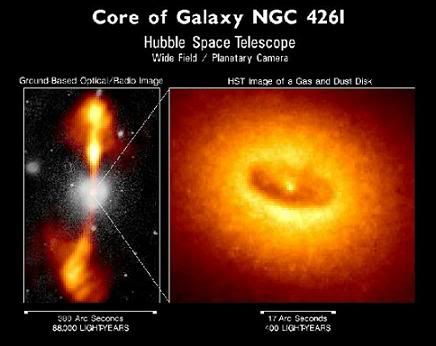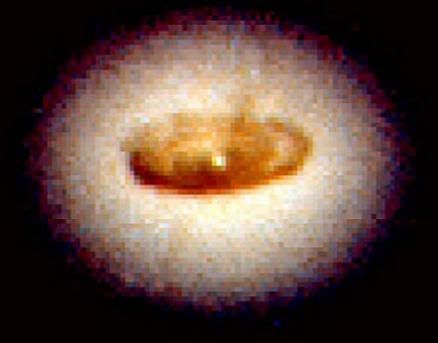Post by glactus on Jun 16, 2009 4:08:53 GMT

NGC 4261 is a giant elliptical galaxy in the Virgo cluster, a collection of thousands of galaxies that are bound to each other by their mutual gravitational pull.
Statistics:
Constellation: Virgo
Distance from Earth: 55 million light years
Magnitude 8.8
Diameter 127,000 light years
Mass: several trillion stars
The Hubble space telescope found that the center of NGC 4261 is an extraordinary region. It appears to contain a supermassive black hole at least a half-billion times as massive as the Sun.
A disk of cold, dark dust about 800 light-years wide encircles it and both the black hole and the disk are offset from the center of the galaxy by about 20 light-years, which is unusual.
At the inner edge of the disk, the material begins to heat up as the black hole's gravity pulls it ever closer. Some of this material falls into it, but some of it, perhaps driven by powerful magnetic fields, shoots back into space at almost the speed of light.
This material forms two "jets" that appear to come from the magnetic poles of the black hole, and the particles and radiation atributed to them span about 90,000 light-years -- a distance almost equal to the diameter of our own Milky Way galaxy.
There is some spectulation that the central black hole is being fed by some of the remaining gas and dust from the galaxy that NGC 4261 cannibalized.

The Hubble knows. This Space Telescope picture of the centre of the nearby elliptical galaxy NGC 4261 tells one dramatic tale and shows the gas and dust in this disk swirling into the super massive black hole.
The disk is probably what remains of a smaller galaxy that fell in hundreds of millions of years ago, and collisions like this may be a common way of creating such active galactic nuclei as quasars.
Credit: These are NASA images: Sources: Wide-Field and Planetary Camera of the Hubble Space Telescope and National Radio Astronomy Observatory.
L. Ferrarese (Johns Hopkins University) and NASA.
hubblesite.org/newscenter/archive/releases/1995/47/image/a/


